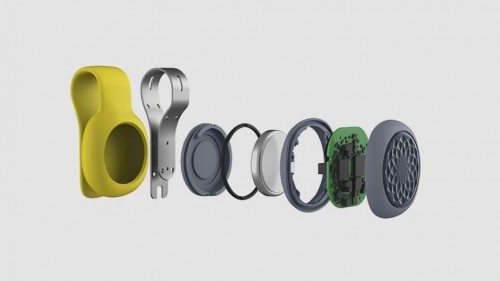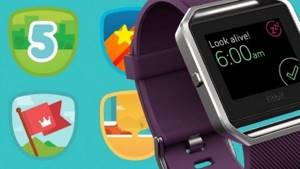Lately, many people have seen some kind of “smart” accessory on their hands. For some it is a smart watch, sometimes more like a smartphone, for others it is a fitness bracelet, depending on the goals being pursued.
What a smart watch is and what it is needed for, we have already written in this article, but now we will figure out what a fitness bracelet is, what it is needed for and what it can do.
Fitness bracelet and its functions
What is a fitness bracelet (tracker, fitness watch - these are all synonyms), and what is it for? I'm telling you!
This is a gadget that is worn on the hand and looks like a watch.
Its functions are numerous and varied. Such a smart machine has special sensors that perform a variety of jobs:
- count steps;
- track daily activity;
- measure the pulse;
- count the calories you burn;
- normalize sleep;
- forward your calls and messages;
- monitor heart health;
- make it possible to read messages and letters;
- allow you to set goals for specific periods of time;
- can serve as a smart alarm clock;
- measure the duration of REM and deep sleep;
- keep a calendar of your workouts;
- and perform various other useful actions.
Details
The Jawbone UP3 is still one of the most sensor-packed trackers, including a temperature sensor, a bioimpedance sensor, and an accelerometer, which we already mentioned. Bioimpedance sensors measure the resistance of small electrical currents to your skin.
Other wearables use optical sensors to measure your heart rate by shining a light through your capillaries, with a similar sensor measuring the speed at which your blood is pumped through your veins (and thus measuring your heart rate).
These optical sensors are less effective than bioimpedance analysis sensors as a measure of overall health, but are very effective at determining your heart rate, both at rest and during activity.
The quality of your sleep is tracked in a similar way: a process called actigraphy uses a hand movement control device to switch the tracker to sleep phase control mode. These sensors are not as accurate as polysomnography, which is what specialists use to measure sleep in a laboratory; a polysomnograph monitors brain activity, not how much movement occurs during sleep.
Several in one
That is, one such smart bracelet can replace several complex, expensive and bulky devices at once: pedometer, heart rate monitor, gyroscope, alarm clock, blood pressure monitor, accelerometer, spo2 sensor and others. And also a whole personal trainer!
Using Bluetooth® Smart technology, the fitness bracelet can be paired with various other gadgets - to build charts, communicate, build routes, track your progress, and so on.
An additional plus is that the device easily synchronizes with your smartphone. Thanks to this, it frees the hands of its owner. At the same time, it makes it possible to read letters in the mail and see all the messages that arrive on your smartphone.
I would like to immediately dispel a very common myth: this device is required not only by women and athletes, no!
After all, a fitness bracelet is not a decoration, but a reliable means of monitoring your health.
Therefore, it will help children and adolescents, and will also be useful for older people who want to monitor their health indicators.
Sensors

Simply put, fitness trackers are activity trackers: Most modern wearables come with a 3-axis accelerometer to track movement in each direction, and some models come with a gyroscope to measure orientation and rotation.
The collected data is then converted into actions and activities, and then the number of calories consumed and the quality of sleep are determined, although in some sense the principle of calculation of the data is based on guesswork.
That is, an altimeter that can measure height is used to count flights of stairs. All this information is collected and compiled to create an overall picture of your activity level, with more sensors leading to more accurate data.
These sensors measure the acceleration, frequency, duration, intensity and pattern of your movement—all together providing an optimal set of data. Therefore, when choosing a tracker model , be sure to look at the technical characteristics of the device regarding the presence of a set of sensors that will be directly involved in collecting data about you.
How does a fitness bracelet work?
The gadget consists of a capsule, which is literally stuffed with a variety of sensors. And also from the bracelet itself. It can also be equipped with a display. Each sensor records its own indicators, for example, the duration of your activity, calories burned, running speed, sleep duration.
Next, the device, synchronizing with your smartphone, sums up the results, collects data, and gives it to you in the form of graphs, scales, specific numbers and even recommendations. The accuracy of the results that will be displayed for you depends directly on the power, sensitivity and quality of the sensors, as well as on their quantity.
In the application, you can easily select the type of activity you are doing (stretching, Tabata, aerobics, Pilates, cross fitness, regular running, Nordic walking, body balance and many others) to get results for a specific activity.
Even swimming can be an activity - after all, there are bracelets with reliable water protection designed for water sports.
It is interesting that only the developers of these super-smart devices themselves know how the algorithms that calculate numerous indicators work. For obvious reasons, manufacturers keep this information in the strictest confidence!
This bracelet looks extremely stylish and has a modern, laconic (usually) design. Due to this, it can be easily combined with both a sports and a business suit. The device weighs minimally (usually up to 30 grams), does not interfere with movement, and does not hinder movements. High-quality models are practically not felt on the wrist at all.
How to use
How to turn it on:
- After purchase, put it on the charger that comes with the kit. After this, the bracelet will turn on automatically.
- Install a special application on your phone via Google Play Market or AppStore.
- Open, log in, find the pairing screen and select your tracker from the available ones.
- Synchronization will take some time, after which you will receive a notification that the pairing process is complete.
- After this, you can set the desired settings.
How to setup:
- Indicate the hand on which the bracelet will be worn. The accuracy of its work depends on this.
- Check the boxes next to the parameters that will be displayed. Mark only those that need to be worked on. If you don't count calories, you don't need them. If you do not monitor your heart rate, remove the mark.
- Set the time format if there is a clock. If you are keeping track of time, make them larger and brighter.
- Activate the bracelet to turn on when you raise your hand. This will increase battery life.
- Select when it is convenient to track your heart rate: only during sleep, only during training, or constantly.
- Enable or disable sleep monitoring and smart alarm clock.
- In some models, you need to work with settings for notifications about calls, SMS, goal achievements, and applications. Determine which ones are important and which ones should be discarded.
It is more convenient to set the settings through the mobile application immediately after installation on the phone.
How to wear:
- Wear on your less active hand for more accurate results. Right-handers - on the left, left-handers - on the right.
- Don't change hands.
- If you have a heart rate monitor and blood pressure monitor, wear it at a distance of 2-3 cm from the palm so that the LEDs that track your heart rate and pressure pass over the line of blood vessels.
- The capsule (back side of the screen) should fit snugly to your hand.
- At the same time, do not tighten the strap too tightly - this may distort the accuracy of the data obtained.
- Once a day it is necessary to remove it to allow the skin to breathe. This is especially true for silicone devices, under which moisture often accumulates, causing irritation and erosion.
- A regular watch should be positioned above a fitness bracelet.
- Simultaneous wearing of a fitness bracelet, a regular watch and jewelry made of any metal is not prohibited.
Fitness bracelets must be regularly cleaned with special aerosols, as they come into contact with pathogenic microorganisms on the skin, micro-discharges, and then can become a source of infection. The rules on how to do this are usually described in detail in the attached instructions. If a branded cleaning liquid is not available, a soda or soap solution can be a substitute.
It is also worth regularly checking the straps for signs of wear and tightening the screws, if any.
Why do you need a fitness tracker?
You definitely need such a smart gadget if you:
- want to start training at home, without a trainer;
- you have your own weight loss program, but there is no motivator and calorie counter;
- you move little, sit and lie a lot, but want to increase your activity;
- want to improve the quality of your sleep, know exactly when it’s best to wake up;
- monitor your body’s indicators (pressure, heart rate, as well as their dynamics);
- you want each workout to be effective, but safe for the heart and the body as a whole;
- want to keep a food diary, know how much fat, protein, carbohydrates and calories you consume;
- you need competent recommendations from your own smart trainer;
- want to track your progress.
Algorithms

As you already know, the readings of different fitness trackers in terms of activity and other indicators vary. That's because the sensors inside each device aren't perfect at measuring your activity—they all use slightly different algorithms to translate raw data into actual statistics.
For example, your tracker might pick up a small hand movement and not count it in your step count because it was barely noticeable. A purely philosophical question arises: what is considered small and how small is really small? Different devices will have different thresholds and thus produce different values.
The accuracy of your fitness tracker's can be affected by uneven road surfaces, cleaning the house with a vacuum cleaner in hand, or simply knocking dust out of the carpet.
When it comes to calories, the app requires more than just counting steps to make the calculation: that's why you'll be asked to enter your age, gender, height, and weight.
The algorithms used by each manufacturer are not made public as privacy is paramount regarding the technologies manufacturers use to get the best and most accurate results, but the more sensors and data points used, the more accurate the results will be.
To actually tell you how many calories you're burning, for example, the tracker would need to add your heart rate and the intensity of your workout based on the number of steps you took.

One of the most well-known tracking solutions is the MotionX platform, which you can find in Nike's running apps, the latest Swiss smartwatches, and other cutting-edge wearables. Philip Kahn, co-founder and CEO of FullPower developer MotionX, explained how the signal processing procedure inside the fitness tracker allows the collected source data to be cleaned.
“Imagine that you are at a concert of your favorite artist. You simply make a low-quality recording of the concert on a dictaphone, depending on your place in the hall. Along with the music, the recorder picks up all sorts of noises around you: shuffling feet, sounds of conversations, chatter, interactions..., so to make this recording high-quality, you need to reduce extraneous noise to a minimum.”
And the quality of that cleaning varies from tracker to tracker, according to Kahn. The techniques used range from simple to complex, but MotionX does them all: Fullpower uses over 100 dedicated engineers to fine-tune the accuracy and efficiency of its software, and the company has invested over $50 million in developing the next generation of algorithms—that's a big deal.
Main types and choice
Fitness trackers today are being produced very actively, by a variety of developers. Which one to choose? It's nice that you can choose a simple and inexpensive bracelet for yourself. At the same time, it surprises with its functionality.
Here are the most popular and worthy models:
- Xiaomi Mi Band 2 is an inexpensive and functional bracelet, quite suitable for regular use in everyday life;
- HONOR Band 5 is an inexpensive, very convenient tracker with a tempered glass screen and simple controls (even an elderly person can figure it out), very accurate;
- Fitbit Flex 2 is a functional and very stylish tracker, but its price is not exorbitant, waterproof, and suitable even for swimmers;
- Garmin Vivosmart HR is a tracker with powerful vibration and many functions that will make even a very lazy person active;
- Huawei Fit is ideal for runners and serious athletes, with many features and high precision;
- Asus ZenWatch 3 is a smartwatch designed more for professional athletes with serious workloads.
There are many types of trackers, there are devices for beginners and for professionals. They can even be intimidating to those new to the topic. Where to start to make the best choice and buy the perfect one for you.
Therefore, it is advisable to take into account the following factors when choosing a fitness bracelet: your lifestyle, your wishes and problems, design, functionality, manufacturer reliability, cost, reviews from owners.
Video review of how the Xiaomi Mi Band 2 fitness bracelet works
What is the advantage of wearable electronics?
A wearable device is often used to monitor a user's vital signs or pieces of data related to his/her health and fitness, his/her location, or even his/her emotional state or response to a particular activity. Wearable device models can be configured to support a range of short-distance wireless systems, such as Bluetooth or local Wi-Fi network support.
Examples of wearable devices include various types of computerized wristwatches such as the Apple iWatch, as well as fitness devices and the revolutionary Google Glass - the first device of its kind to integrate an activity tracker directly into the glasses.
Some of the issues surrounding wearable devices include privacy, the extent to which they change the concept of social interactions, what users look like when worn, as well as questions regarding user-friendly design and customization issues.
Such devices are almost invisible on the wrist: they count steps, track sleep, track heart rate and are able to distinguish the level of exercise - from a light jog to a hard sprint. But how exactly does your fitness tracker keep track of all the stats that appear in the app on your smartphone or computer?
The new Fitbit or something like Garmin's Vivosmart 3 is trying to make sense of the data. How?
Read on to take a peek behind the curtain and learn why tracking with a fitness tracker isn't an exact science.
Useful gift
By the way, not so long ago I gave a tracker to my uncle, who is already quite elderly. No, he is not an athlete, but he takes care of his health. And the new gadget helps him a lot - the man strives to achieve the recommended number of steps per day.
That's why he walks a lot. Measures your pulse, improves your sleep and even monitors your heart. In the summer I even swam in the lake wearing the bracelet; it was interesting to check its water resistance. In general, for my uncle, the tracker turned out to be both a healthy thing and a new, interesting hobby, which I am very happy about!
By the way, you can buy yourself a high-quality fitness bracelet (until February 1, 2021 at half price with free delivery via the link). You can also compare prices and choose a suitable bracelet in the Yandex market.
Introduction
A more popular name for such devices and devices is “Fitness trackers”, from the English word “to track, tracking” - to monitor, monitor. And the word fitness in the name means that they are intended to record your sporting achievements, but not only. Such sensors will help you monitor the number of steps, distance traveled, calories burned, and so on. As practice has shown, the most convenient form factor, which does not annoy you, does not take up space and is practically invisible both during daytime activity and during sleep, is a bracelet. This smart fitness bracelet will be our test subject today.
Operating principle of capacitive and piezoelectric accelerometers
The most common types of electronic accelerometers:
- capacitive;
- piezoelectric.
The principle of their operation is not very different from the analogues that were used in mechanical pedometers, where the sensitive element was a spring on which a load pressed. In capacitive devices, the sensitive element is capacitor plates.
The distance between the plates of a capacitor and its capacitance are inversely proportional. While walking, the load presses on the plates, reducing the distance between them and increasing the capacity.
This data is recorded by the controller and transmitted to the microprocessor, which, after analyzing it, counts additional steps taken or perceives them as just a hand gesture.
In piezoelectric accelerometers, crystals of piezoelectric substances are used as a sensitive element. It can be quartz or lead titanium zirconate. When these substances are deformed by a load during movement (walking), the potential difference changes. It is registered by a potentiometer and transferred to the microprocessor for further processing.
To get rid of stress in your life
Stress is one of the biggest health risks in the 21st century, which is filled with anxiety. As you probably know, stress can lead to heart disease, obesity, diabetes, gastrointestinal problems, headaches, anxiety, and even asthma. It reduces attention levels, disrupts sleep, and reduces a person's emotional well-being or satisfaction. As a result, it affects everything. However, stress can be successfully managed with the help of technology.
There are many ways to effectively reduce your stress levels, and you should definitely take the time to find the best way to do so. A popular method is meditation. It has been scientifically proven that in order to reduce symptoms associated with stress, depression and anxiety, it is enough to meditate for just 5 minutes a day. And activity trackers with a playlist management function can again help in achieving mental clarity.

Heart rate tracking
Why is such a gadget function needed? A fitness bracelet with a heart rate monitor allows you to achieve maximum efficiency of any type of physical activity. It is known that control over the beats of the heart muscle can monitor a person’s response to stress. In addition, this function helps to properly organize the training process. So, if a fitness bracelet with a heart rate monitor is worn on the hand of a person whose purpose of morning jogging is to eliminate extra pounds, then he will need to keep his heart rate at 130 beats per minute. With higher or lower values of this indicator, fats will be burned more slowly. This will lead to the fact that the training will simply be wasted.
Functions of these devices
Fitness watches also have other functions:
- Pedometer
– the accuracy of this function can range from 3% to 30%. He may react to fidgeting in one place or driving over uneven terrain in a vehicle. Of course, such failed steps initially lead to bewilderment, but with practice a person begins to correctly identify important information from the device. - Sleep analysis
is another important function that will help you monitor the quality of your rest, which will make it possible to avoid many health problems. - Inactivity time
- this function is not included in all sports watches for fitness, but it monitors your activity, if you have been sitting longer than expected, it will spur you into action and make you move. - Calories burned
– to calculate this information, the devices take into account your overall activity along with your height, weight and age. By monitoring the calorie content of foods and overall activity, you can calculate the amount of weight gain or loss. This calculation leads to its own motivation.
Devices with heart rate monitor
A fitness watch with a heart rate monitor will give you more detailed information in this direction. Naturally, when you do, for example, fitness dancing, the presence of a stopwatch or timer is important for you, but a heart rate monitor is even more necessary. A heart rate monitor
is a device that records the heart rate; it measures the pulse and reports its frequency to the owner. The device is compact in size and folds into two halves.
- The first part is a sensor
, it is placed on the chest or arm. Using two electrodes, it controls the number of impulses received from the heart and detects the potential difference on the surface of the hand at the same moment, thereby identifying the pulse rate. - The second part is the receiver
located in the device. It is there that information about all the heart rate monitor calculations is received and the person sees everything on the dial.
Today, a heart rate monitor is available not only to professional athletes, but to people who want to know everything about their health. In connection with this, heart rate monitors are ultra-precise with additional information and for sports. This device will help you see the real picture of the effectiveness of exercise on a fitness mat, and there is no need to take time off from your workout.
For welfare purposes
The most common mistake people make is when they want to use technology to speed up the pace of life. But when choosing a wearable device, you should consider that it will suit your needs. Therefore, you must understand exactly what in your life requires changes at the moment. We recommend that you keep a health diary, which you can organize as a simple Excel spreadsheet or Google spreadsheet.
You can enter data about your psychophysical or psychoemotional state into it. Such a table will allow you to identify the peculiarities of the functioning of your body, your needs, and most importantly, understand what needs to be changed now, because understanding the essence of the problem is the first step to solving this problem. Improving the quality of life begins with taking care of health, and technology in this matter is only a secondary, but at the same time an integral tool.
You can learn everything about technical devices that make a person’s life easier and achieve their goals in the following article: Fitness bracelet with heart rate monitor.
User reviews
“I have been wearing a Xiaomi fitness bracelet for 1.5 years. It is an indispensable assistant for me, especially during periods of active training. I try to monitor my health and nutrition, and the device helps me with this.” Andrey, 23 years old
“I gave a fitness tracker to my husband for his birthday, and now I’m thinking about buying one for myself. He's delighted! Summer is just around the corner, it’s time to lose weight, and I hope it will be much easier with a bracelet!” Alena, 27 years old
See what kind of fitness bracelets there are:
More interesting articles:










